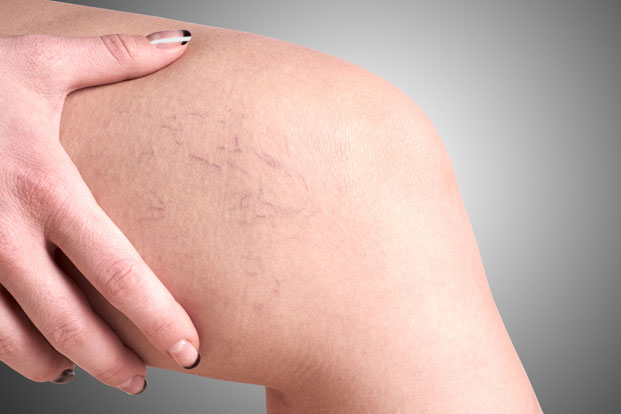Are frustrating varicose veins making you want to skip swimsuit season?
Varicose veins are a reality for many Americans. In fact, the Chicago Vein Institute reports that more than 40 million of us are affected by this issue. And half of the 50-plus population has varicose veins.
Women are affected more often than men, with 41 percent of women 50 or older saying they have developed varicose veins. Plus, if you are a woman, and one parent has them, your chances of developing them are 60 percent. Weight also increases the risk, making it important to keep extra pounds off.
Genes can be a factor as well. The Chicago Vein Institute says that 50 percent of those with varicose veins report this issue in their families. So if your mom or dad has them, your chances of developing them increase. And if both your parents have them, you have nearly a 90 percent chance of having the same issue.
What Are Varicose Veins?
According to the Mayo Clinic, varicose veins are basically enlarged veins. Though any vein can turn into a varicose vein, varicose veins are most often seen in the legs and feet. They are thought to be a result of pressure caused by standing and walking.
Usually, these veins aren’t dangerous — just unsightly. However, they can pave the way to more serious health problems. That’s because varicose veins can be painful and signal circulatory issues.
The Mayo Clinic says that varicose veins will appear “dark purple or blue in color” and may look twisted. And if you do feel them, your legs may hurt or feel heavy. Plus, they can burn, and your lower legs may swell. The pain may get worse if you’re on your feet or stuck in a chair for too long. They may even itch, and your skin may appear red.
Another issue is spider veins, which can literally look like a spider web. According to the Mayo Clinic, spider veins are smaller than varicose veins. These little guys are located closer to the surface of the skin and might be red or blue. They can be seen in the legs and even on the face.
Varicose Vein Prevention
There are ways to prevent varicose veins, even if you may be predisposed to them. According to the National Institutes of Health (NIH), preventing these nuisances involves lifestyle changes. This can help with pain and keep the issue from getting worse.
The first change that you can make is to refrain from standing or sitting for too long without giving your body a breather. Try not to cross your legs when you do sit – this is said to contribute to the incidence of varicose veins. It also helps to raise legs above your heart when you’re watching television or lying down.
Second, make it a point to get active. The NIH says that physical activity keeps blood moving. Plus, it will add muscle, making your legs look even better. Try to lose weight if you’re carrying extra pounds, which makes it easier for blood to circulate and takes pressure off of your veins.
Third, give the tight clothes a rest. Yes, we love skinny jeans, but they may exacerbate varicose veins. When clothes are too tight in the waist, thighs and legs, they can add to the problem of varicose veins. Instead, choose clothes that allow your body to breathe and move. And save those high heels for special occasions.
Fourth, compression stockings can help. Though they’re not fashionable, they are a great option to prevent varicose veins. Compression stockings keep the blood from pooling in the legs because of the continued pressure the hose supplies. They are also said to decrease swelling.
The NIH says that there are three different types of these stockings. The first is support pantyhose, which are said to offer the lowest amount of pressure on the legs. The next step up would be over-the-counter compression hose. This option doesn’t supply the most pressure possible, but the pressure is greater than you would find with support pantyhose. And finally, you can obtain prescription-strength compression hose. These can be found in medical stores or pharmacies. With this option, a fitting is required.
Varicose Vein Treatment
You can also get varicose veins treated. According to Everyday Health, one option in this respect is vein stripping, which is also called a phlebectomy. In this instance, a surgeon will make incisions close to varicose veins and remove them. This gets rid of the problem, but it is an invasive procedure.
This may be performed with an ablation, which is also referred to as radiofrequency ablation. According to Everyday Health, this procedure has been available for about 10 years. In this method of treatment, a laser is used to heat the vein, which causes the veins to diminish in size. The body eventually absorbs them completely.
This treatment method can cause bruising and discomfort. The area has to be numbed, which can be frustrating for those who fear anesthetic. However, results are rapid, and patients notice changes within a week or two.
Another option is non-thermal ablation. According to Everyday Health, two techniques have been approved by the U.S. Food and Drug Administration (FDA) in this respect. The first of these options is called Varithna. This is a medicated foam that abolishes varicose veins. And secondly, VenaSeal is a method that involves glue that is said to “shut off the vein.”
That said, you don’t want to go to just anyone for treatment. Experts tell Everyday Health that it’s essential to go to a physician or clinic accredited by the Intersocietal Accreditation Commission. You want a specialist on your team. This gives you the best and safest possible chance of removing varicose veins.

Leave a Reply